S.McWhirter–G.Sargent
Route 20 Chess Club
Freeport, Illinois, Aug. 31, 2010
1.e4 e5 2.Nf3 Nf6 3.Nc3!? Bb4 4.a3 Bxc3 5.dxc3 0-0?
Misses an opportunity to swing the balance. If Gary plays 5...d6, Steve can't take the e5-pawn, but Gary still has a shot at the e4-pawn.
6.Nxe5
PREVED PETRAV!
6...d6
A moment too late, and not as forceful as 6...Re8!, which has the added effect of pinning the d4-pawn before capturing it.
7.Nf3 Nxe4 8.Bd3 Nf6 9.0-0 Bg4 10.Re1 Nbd7 11.Be2
11...Ne5
Gary should not be dilly-dallying about getting his rook on the e-file. Besides, there's no downside to 12.Nxe5 Bxe2 13.Qxe2.
12.Bg5 h6 13.Bh4
13.Bxf6!? Qxf6 14.Nxe5 Bxe2 15.Qxe2 dxe5 16.Qxe5 Qxe5 17.Rxe5 leaves Steve a pawn ahead when the smoke clears.
13...Ng6 14.Qd4 Nxh4 15.Nxh4 Bxe2 16.Rxe2 c5 17.Qd3
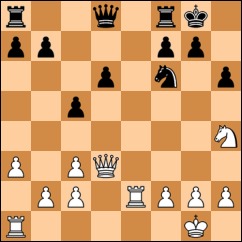
17...Qd7
Leaves Gary vulnerable to 18.Nf5, attacking the pinned, backward d-pawn. After 17...Nh5, the same move by white fails because of the knight fork threat on f4.
18.h3 Nh3?
This move, which was dandy just a moment ago, is bad now because of the relocation of Gary's queen: 19.Qf5 Qxf5 20.Nxf5. There's still that open e-file . . .
19.Qf3 Nf6 20.Rd1 Rae8
At last!
21.Red2
Huh? A strangely meek move. There's nothing wrong with trading rooks, then attacking that pinned pawn: 21.Rxe8 Rxe8 22.Nf5 Re6.
21...Re6
If Steve isn't going to attack down the e-file, how about having the black knight run interference: 21...Ne4!? 22.Rd3 g6, preparing ...f5? Another plan that Gary should be considering is ...Qa4, attacking the c2-pawn and pressuring the undefended knight on h4.
22.Nf5!
Now it's getting real.
22...Nh7?
Removes coverage of g4, which allows the hit-and-run 23.Qg4!? g6 24.Nxh6+ Kg7 25.Nf5+ Kh8 26.Nxd6.
23.Nxd6 Ng5 24.Qxb7 Qxb7 25.Nxb7
Steve has slickly managed to pick up two pawns without being punished for it. Instead of 23...Ng5, Gary is better off either evacuating (23...b6) or defending (23...Rb8) his vulnerable b-pawn. Otherwise, Steve is liable to hopscotch his way through Gary's material.
25...Rfe8??
25...Rb6 is necessary to gain tempo against Steve's knight, then snag his b-pawn so that things don't get any worse.
26.Rd8 Rxd8 27.Rxd8+ Kh7 28.Nxc5 Re2
29.Kf1
Unnecessary: the king has an escape square, the f-pawn is safe, and there's mischief to be made. For instance, 29.Rd7!, about which no positional player would have to think twice, answering 29...Rxc2 with 30.h4 (with the rook off the e-file, the knight is trapped!) Ne6 31.Nxe6 fxe6.
29...Rxc2 30.Na4
Why put a knight on the rim? He'd much rather be on d3.
30...Ne4 31.f3
...Rxf2+ is not as grave a threat as it might appear. Gary can afford to play 31.Ra8.
31...Nd2+ 32.Kf2
Why step into harm's way? 32.Kg1 Nc4 33.Rd7 will mop things up in short order, as pawns get picked off one by one.
32...Nc4+ 33.Kg3 Nxb2 34.Nxb2 Rxb2 35.Rd7 Rb3 36.Rxa7 Rxc3 37.a4 Ra3
If not for two things, this would be looking disappointingly drawish: Steve's extra pawn and his king's head start toward the center.
38.Kf4 Kg6 39.Ke5 Ra2 40.g4 f6+ 41.Ke4 Rh2 42.Rb7 Rxh3
Might want to pay more attention to that a-pawn . . .
43.a5 h5 44.Kf4
Just sprint, brother.
44...hxg4 45.fxg4
The king capture is better, gaining a tempo off Gary's rook.
45...Rh8?
An uncharacteristic endgame miscalculation from Gary, who knows well that the rook needs to be behind the passed pawn. But both Gary and Steve are in time trouble, so the moves are coming fast and sloppy.
46.Rb3 Re8? 47.a6 Kf7? 48.g5?? (48.a7 g5+ 49.Kf3) fxg5+ 49.Kxg5 g6? 50.a7?? (50.Rf3+ Kg7 51.Ra3) Re5+ 51.Kf4 Re8?? (51...Ra5 52.Rb7+ Ke6 Rg7) 52.a8Q
52...g5+ 53.Kf5 (53.Kxg5 Rxa8 is a certain draw) g4?? (ditto 53...Rxa8 54.Kxg5 Ra1) 54.Qd5+ Kf8 55.Qd6+ 1-0
And Gary runs out of time. Steve has only 5 seconds left, three moves from checkmating him, and breathes out his gratitude for move delay.
Bonus!
K.Ammann–D.Velazco
Route 20 Chess Club
Freeport, Illinois, Aug. 31, 2010
White to move. (Highlight to reveal answer.)
1.Nxc6! Bc5+ (1...bxc6 2.Bxc6+ Kf7 3.Bxa4+−) 2.Kh1 (better is 2.Be3+−) g5 (2...Kf7 3.b4 Bd6 4.Rd1 Bc7+−) 3.Rxe6+ (3.b4 Kd7 4.bxc5 bxc6 5.cxb6+−) Kf7 4.Bd5 (4.Rxf6+ Kxf6+−) bxc6 5.Re4+ (5.Rxc6!?+−) cxd5 6.Rxa4+−

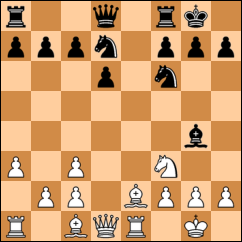
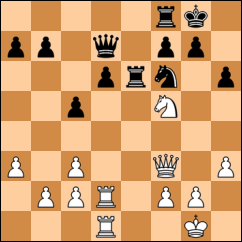
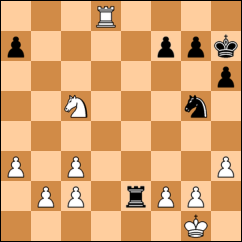
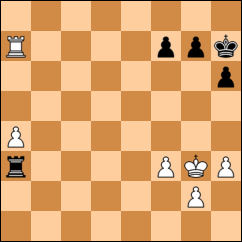
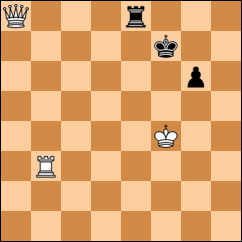
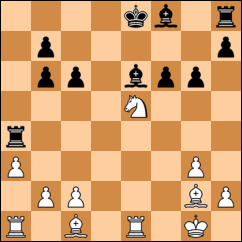



0 comments:
Post a Comment